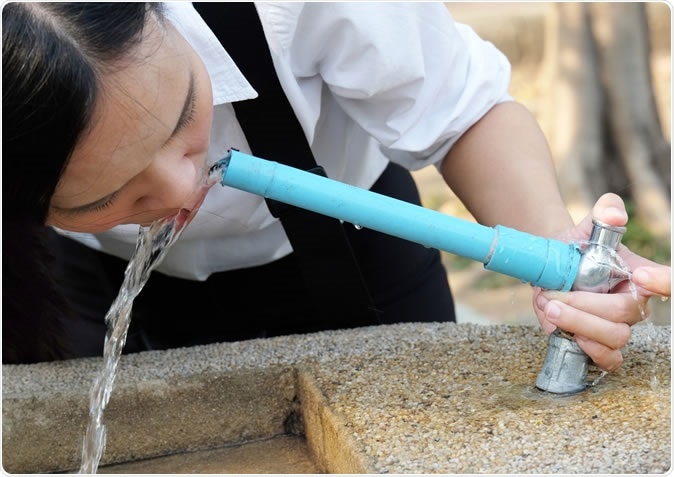Over 6,500 new cases of bladder cancer in Europe are caused by exposure to chemicals called trihalomethanes (THM) found in drinking water. This number adds up to almost 5% of all bladder cancers in the continent. The study, published in the journal Environmental Health Perspectives in January 2020, is a pioneering attempt to establish the levels of these chemicals in tap water supplied in 26 countries in the European Union.

Image Credit: Thananya Apiromyanon / Shutterstock
What are THMs?
THMs are by-products of the process of disinfecting water for drinking purposes. It is already known through earlier studies that being exposed to THMs through various routes, including via ingestion, inhalation or skin contact, increases the risk of bladder cancer. However, the new study used information on the levels of THMs present in tap water in European cities, to compute the attributable risk of bladder cancer. In other words, the authors wanted to find out how many of these tumors arose due to exposure to THMs in drinking water.
The study
The researchers first took on the onerous task of getting the information about the THM levels that could be taken as representative for the whole country, for each of the countries in the EU. In order to obtain this data, the researchers asked municipal water quality assurance staff to fill out questionnaires that asked for the concentrations of both total and individual THMs in water samples collected from the tap, as well as within the distribution pipes and at the plants where the water was treated.
In addition to the municipal data, they also made use of open data sources online, water quality reports and scientific literature on this topic. They collected data on the levels of individual THMs, namely, chloroform, bromodichloromethane, dibromochloromethane, and bromoform for their study.
Finally, they were able to collate the desired information from 26 countries in the EU, except for Bulgaria and Romania, which gave them data on 75% of the population. They couldn’t get all the data they wanted for the purposes of the study from these countries.
Reflecting on the task, researcher Cristina Villanueva, who works with the Barcelona Institute for Global Health (ISGLOBAL) which coordinated the study, says wryly, “We hope that these data will become more readily available in the future.”
The results
The findings showed a lot of differences between the THM levels from country to country. In all EU countries, the level in drinking water was, thankfully, well below the permissible EU limit of 100 μg/L, at an average of 11.7 μg/L. However, the highest concentrations to be reported were above the limit in 9 countries, ranging from Cyprus and Hungary to Ireland, Spain, Portugal and the UK. This makes the study especially relevant to those countries, as well as over a dozen countries with high average THM levels.
Attributable bladder cancer risk
The researchers now did some statistical work to find out how the average THM level was associated with the incidence of bladder cancer in each country, using the international bladder cancer database. This enabled them to estimate the number of cases that could be ascribed to THM exposure.
As a result, they found that about 6,500 bladder cancer cases each year could be said to be due to THM exposure. Of course, the attributable risk varied from country to country, with the highest burden being in Spain and the UK, at about 1,500 and 1,350 cases respectively, both because of the greater number of cases and the higher number of people. The highest attributable percentage of cases was found in Cyprus, at 23%, while Malta and Italy had 17% and Spain and Greece about 10%.
The lowest attributable risk was in Denmark, at 0%, while the Netherlands, Germany, Austria and Lithuania had less than 0.5%.
Implications
The researchers commented, “Over the past 20 years, major efforts have been made to reduce trihalomethanes levels in several countries of the European Union, including Spain. However, the current levels in certain countries could still lead to considerable bladder cancer burden, which could be prevented by optimising water treatment, disinfection and distribution practices and other measures.”
The best way to reduce these levels is to begin with the 13 countries in which the average levels are highest. Once these come down to the EU average of 11 μg/L, the estimated number of bladder cancers due to this reason could be reduced by 44%. This study thus shows the burden of bladder cancer attributable to THM exposure in tap water and suggests ways to control it.
Journal reference:
Trihalomethanes in Drinking Water and Bladder Cancer Burden in the European Union Iro Evlampidou, Laia Font-Ribera, David Rojas-Rueda, Esther Gracia-Lavedan, Nathalie Costet, Neil Pearce, Paolo Vineis, Jouni J.K. Jaakkola, Francis Delloye, Konstantinos C. Makris, Euripides G. Stephanou, Sophia Kargaki, Frantisek Kozisek, Torben Sigsgaard, Birgitte Hansen, Jörg Schullehner, Ramon Nahkur, Catherine Galey, Christian Zwiener, Marta Vargha, Elena Righi, Gabriella Aggazzotti, Gunda Kalnina, Regina Grazuleviciene, Kinga Polanska, Dasa Gubkova, Katarina Bitenc, Emma H. Goslan, Manolis Kogevinas, and Cristina M. Villanueva, https://doi.org/10.1289/EHP4495